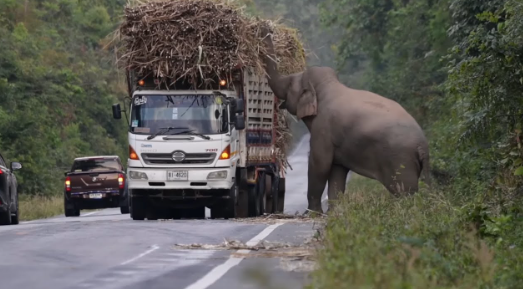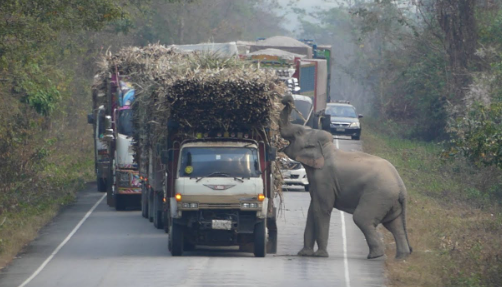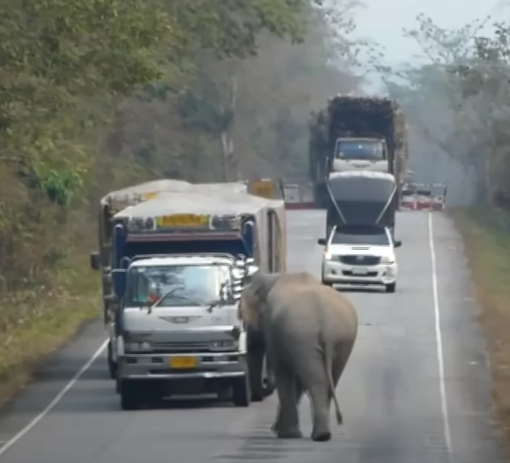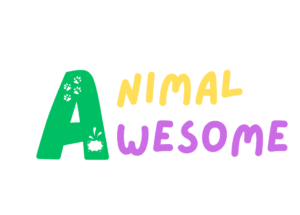In the heart of Thailand’s Chachoengsao Province, a wild elephant named Fatty has become a local legend for stopping trucks in search of his favorite treat: sugarcane.
This blog explores the intriguing behavior of Fatty and the impact he has on both the local community and wildlife conservation efforts.
Introduction to Fatty
Fatty is not just any elephant; he is a charismatic figure who embodies the spirit of the wild. Known for his playful antics and insatiable appetite for sugarcane, Fatty has captured the hearts of many.
His adventures are a testament to the bond between nature and local culture, showcasing the unique relationship that exists in Chachoengsao Province.
Understanding Fatty’s Behavior

Fatty’s behavior is driven by instinct and learned experiences. Elephants are intelligent creatures, and Fatty has learned that sugarcane trucks are a reliable source of his favorite snack. His ability to navigate the landscape and interact with humans highlights his adaptability and cunning nature.
The Setting: Chachoengsao Province
Chachoengsao Province, located in central Thailand, is a region rich in natural beauty and agricultural abundance. The landscape features lush fields, winding rivers, and a vibrant ecosystem, making it a perfect habitat for wildlife, including elephants like Fatty.
The Agricultural Landscape
The province is known for its extensive sugarcane plantations. These fields not only provide a livelihood for local farmers but also attract wildlife seeking food. Fatty’s presence in this environment is a natural consequence of the abundant resources available.
Community and Culture
Chachoengsao is home to a close-knit community that respects and coexists with nature. The local culture celebrates wildlife, and Fatty has become a symbol of this harmony. His visits to the sugarcane trucks have sparked conversations about conservation and the importance of protecting these majestic creatures.

The Sugarcane Trucks
Every year, as the sugarcane harvest approaches, trucks filled with fresh sugarcane traverse the roads of Chachoengsao. These trucks have become a beacon for Fatty, who eagerly anticipates their arrival.
The Routine of the Trucks
- Timing: The trucks typically operate during the early morning and late afternoon, aligning perfectly with Fatty’s foraging habits.
- Routes: They follow established routes that Fatty has learned to recognize, making it easy for him to plan his encounters.
- Volume: The sheer volume of sugarcane transported attracts not only Fatty but also other wildlife, creating a bustling scene during harvest season.
Fatty’s Tactics
Fatty has developed a unique set of tactics to approach the sugarcane trucks. His size and strength allow him to command attention, and his gentle yet persistent demeanor often leads to the drivers sharing their load. This interaction exemplifies the mutual respect that has developed over time.
Fatty’s Annual Visits
Fatty’s annual visits have become a celebrated event in Chachoengsao. Locals eagerly anticipate his arrival, often sharing stories of his previous encounters with the sugarcane trucks.
Local Festivities
During the sugarcane harvest, the community often organizes small festivities in honor of Fatty. These gatherings include traditional music, food, and storytelling that highlight the bond between the people and the elephant.

Documenting the Visits
- Photography: Many locals and tourists take the opportunity to capture photographs of Fatty, creating a visual record of his adventures.
- Social Media: Fatty has become a social media sensation, with posts and videos showcasing his playful nature and interactions with the trucks.
- Conservation Efforts: These visits also spark discussions on conservation, raising awareness about the challenges faced by wild elephants in Thailand.
Local Reactions to Fatty
The reactions of the local community to Fatty’s visits are a blend of amusement, admiration, and concern. His antics often draw crowds, but they also raise important questions about human-wildlife interactions.
Community Engagement
Many residents view Fatty as a local treasure. The joy he brings is palpable, and people often gather to watch his playful behavior. Children, in particular, are fascinated by his size and charm.
Conservation Concerns
While Fatty’s visits are celebrated, they also bring attention to pressing conservation issues. The interaction between wild elephants and human activities can lead to dangerous situations. Discussions surrounding safe coexistence are crucial for ensuring both human and elephant safety.
Educational Initiatives
- Workshops: Local NGOs often conduct workshops to educate the community about wildlife conservation and the importance of protecting natural habitats.
- School Programs: Schools incorporate Fatty’s story into their curriculum, teaching children about wildlife and environmental stewardship.
- Community Patrols: Local volunteers participate in patrols to ensure that both Fatty and the community remain safe during the sugarcane season.
The Behavior of Wild Elephants
Wild elephants, like Fatty, exhibit complex behaviors that reflect their intelligence and social structures. They communicate through a range of vocalizations, body language, and even seismic signals. Fatty’s interactions with his environment demonstrate key aspects of elephant behavior, including foraging strategies and social dynamics.

Social Structures
Elephants are highly social animals, often forming tight-knit family groups. These herds are typically matriarchal, with older females leading and teaching younger members. Fatty, while a solitary figure, exhibits behaviors that suggest he is aware of the social norms when interacting with humans and other elephants.
Foraging and Feeding Habits
Elephants are herbivores and consume a variety of vegetation. Fatty’s preference for sugarcane highlights his ability to adapt his diet based on availability. His foraging behavior not only showcases his intelligence but also his resourcefulness in finding food.
Exploration and Play
Play is a significant aspect of an elephant’s life. Fatty’s playful antics when approaching sugarcane trucks reveal his curiosity and joy. This playful behavior is essential for the development of young elephants, as it teaches them important skills for survival.
Impact on Local Agriculture
Fatty’s visits to sugarcane trucks have profound implications for local agriculture. While his presence brings joy and fascination, it also poses challenges for farmers. Striking a balance between wildlife and agricultural needs is crucial for sustainable coexistence.
Crop Damage
Elephants can cause significant damage to crops when foraging. Fatty’s attraction to sugarcane can lead to conflicts with farmers, who may experience losses during the harvest season. Understanding these dynamics is vital for developing effective management strategies.
Economic Consequences
Farmers face economic pressures due to potential crop loss. The local economy relies heavily on agriculture, and repeated damage can lead to financial strain. It is essential for stakeholders to engage in discussions about mitigating these impacts.

Potential Solutions
- Fencing: Installing barriers around fields can help deter elephants from entering crop areas.
- Deterrents: Using natural deterrents, such as noise or scent, can encourage elephants to avoid certain areas.
- Compensation Programs: Implementing compensation schemes for farmers affected by elephant damage can alleviate economic burdens and foster goodwill.
Conservation Efforts in Thailand
Thailand is home to various conservation initiatives aimed at protecting wild elephants and their habitats. These efforts are essential for ensuring the survival of species like Fatty and maintaining biodiversity.
Protected Areas
Establishing protected areas is a critical step in wildlife conservation. These zones provide safe habitats for elephants, reducing human-elephant conflicts. The preservation of natural ecosystems is vital for the health of elephant populations.
Community-Based Conservation
Engaging local communities in conservation efforts fosters a sense of ownership and responsibility. Programs that involve residents in wildlife monitoring and habitat restoration can lead to successful outcomes. Fatty’s story serves as a focal point for these initiatives, inspiring collective action.
Research and Monitoring
- Tracking Programs: Researchers track elephant movements to understand their behavior and habitat use better.
- Data Collection: Gathering data on elephant populations helps inform conservation strategies and policy decisions.
- Public Awareness Campaigns: Educating the public about the importance of elephants in ecosystems can garner support for conservation efforts.
Community Engagement and Education
Community engagement plays a vital role in conservation. Educating residents about the importance of elephants fosters a culture of coexistence. Programs focused on wildlife education can have lasting impacts on community attitudes and behaviors.
Educational Workshops
Workshops often focus on the ecological roles of elephants and the challenges they face. These sessions encourage discussions about sustainable practices and conservation. By involving the community, these initiatives create a shared understanding of wildlife issues.
Involvement of Local Schools
Schools can be powerful platforms for promoting wildlife conservation. Incorporating Fatty’s story into the curriculum can captivate young minds and inspire future conservationists. Engaging students through interactive activities enhances their learning experience.
Community Events
- Wildlife Festivals: Organizing festivals to celebrate local wildlife can strengthen community bonds and raise awareness.
- Volunteer Opportunities: Providing avenues for community members to participate in conservation activities encourages active involvement.
- Partnerships with NGOs: Collaborating with non-governmental organizations can bring in resources and expertise for effective conservation programs.
The Future of Fatty and His Habitat
The future of Fatty and his habitat hinges on the collaboration between local communities, conservationists, and policymakers. Sustainable practices and responsible wildlife management are essential for ensuring that wild elephants continue to thrive in their natural environment.
Ongoing Challenges
Despite efforts, challenges remain. Habitat loss, human-wildlife conflict, and climate change pose significant threats to elephant populations. Continued advocacy for conservation is crucial for addressing these issues effectively.
Hope for Coexistence
Fatty’s story exemplifies the potential for coexistence between humans and wildlife. By fostering understanding and respect, communities can create a harmonious environment where both people and elephants can thrive. The legacy of Fatty can inspire future generations to protect the natural world.
Call to Action
- Support Local Initiatives: Get involved in local conservation efforts and support organizations working to protect wildlife.
- Spread Awareness: Share knowledge about the importance of elephants and their role in ecosystems.
- Advocate for Policy Changes: Encourage policymakers to prioritize wildlife conservation in their agendas.
